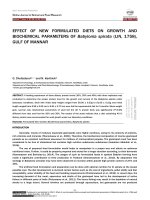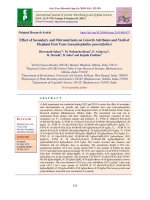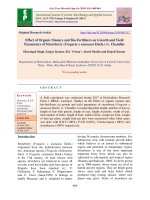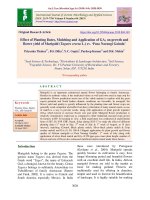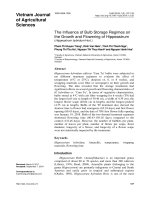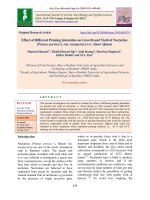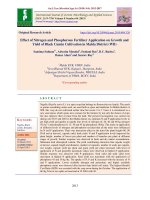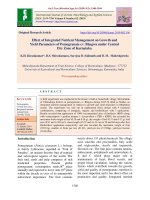Effect of micronutrients on growth and flowering of Gerbera (Gerbera jamesonii) Var. Rosaline
Bạn đang xem bản rút gọn của tài liệu. Xem và tải ngay bản đầy đủ của tài liệu tại đây (355.75 KB, 10 trang )
Int.J.Curr.Microbiol.App.Sci (2020) 9(5): 2042-2051
International Journal of Current Microbiology and Applied Sciences
ISSN: 2319-7706 Volume 9 Number 5 (2020)
Journal homepage:
Original Research Article
/>
Effect of Micronutrients on Growth and Flowering of Gerbera
(Gerbera jamesonii) Var. Rosaline
Aparna Sarkar1*, Tapas Kumar Chowdhuri1 and Raghunath Sadhukhan2
1
Department of Floriculture and Landscape Architecture, Bidhan Chandra Krishi
Viswavidyalaya, Mohanpur, Nadia-741252, WB, India
2
Department of Genetics and Plant Breeding, Bidhan Chandra Krishi Viswavidyalaya,
Mohanpur, Nadia-741252, WB, India
*Corresponding author
ABSTRACT
Keywords
Gerbera jamesonii,
Polyhouse, Iron,
Magnesium, Zinc,
Boric acid
Article Info
Accepted:
15 April 2020
Available Online:
10 May 2020
The present experiment was conducted to study the effect of different micronutrients for improving
the quality as well as yield of Gerbera jamesonii Var. Rosaline considering both vegetative growth
and flowering parameters under protected condition. The experiment was carried out at horticulture
research station, BCKV, Nadia, West Bengal, during the year 2017-2018. Experimental field was
laid out in completely randomized design consisting of thirteen treatments each including three
replicates. Foliar spray of four micronutrients viz., Fe, Mg, Zn and B at three levels (0.4%, 0.6% and
0.8%) were applied. The observations showed that ferrous sulphate at a concentration of 0.6%
recorded the maximum plant height (42.0 cm), the highest no. of flowers/plant (14.7) with the
maximum flower diameter (12.5cm), whereas the best result in terms of no. of leaves (41.0), no. of
suckers (8.0), plant spread (78.0cm) and flower stalk length (71.7cm) was recorded in magnesium
sulphate. Vase life of the cut flower was found maximum in plant treated with 0.6% magnesium
sulphate. No significant difference was found in all treatments regarding flower stalk diameter.
Application of Ferrous sulphate, Magnesium sulphate and Zinc sulphate were found to significantly
increase the growth and flowering of plant. However, application of Boric acid in all levels was
found to be less effective.
Introduction
Gerbera (Gerbera jamesonii) belongs to the
family compositae, which is commonly
known as Transvaal Daisy, Barberton Daisy
or African daisy. It is an important
commercial flower grown throughout the
world in a wide range of climatic conditions.
It produces attractive flowers known as ‘head’
or capitulum in wide range of colors including
yellow, orange, cream, white, pink, brick- red,
scarlet, salmon, maroon, terracotta and
various other intermediate shades.
The plant is dwarf herbaceous perennial and
grows in clump with solitary flower heads on
a long slender stalk, which grows well above
the foliage. Gerbera as a cut flower has
tremendous demand in domestic and
international markets.
2042
Int.J.Curr.Microbiol.App.Sci (2020) 9(5): 2042-2051
It ranks fifth in the international cut flower
market. Due to globalization and income
generation in different parts of the world per
capita consumption of flower in most
countries is increasing rapidly. In recent
years, commercial production of gerbera has
become a major venture in India among the
commercial ornamentals. It is a popular cut
flower in Holland, Germany and USA
(Choudhary and Prasad, 2000; Sujatha et al.,
2002). Gerbera are broadly and commonly
used as cut flowers for flowery array, interior
decoration and gifts for particular occasion,
wedding ceremony bouquet. Micronutrients
play vital roles in the growth and
development of plants, due to their
stimulatory and catalytic effects on metabolic
processes and ultimately on flower yield and
quality (Khosa et al., 2011). Micronutrients
are to be necessarily taken up by the plants
from soil or supplemented through foliar
application for good growth and yield of
crops and maximizing the efficient use of
applied N, P and K. Due to unbalanced use of
micronutrient, the plant growth, development
and quality of flower are directly affected.
Therefore the balanced nutrient application is
necessary for healthy plant growth and
production of quality flower. In the absence
of micronutrients, the plants are known to
suffer from physiological disorders which
eventually lead to imbalanced growth and low
yield of flower. The advantages of foliar
fertilizers were more noticeable under
growing
conditions
restricting
the
incorporation of nutrients from the soil. So,
the present experiment was carried out to
investigate the comparative effect of different
micronutrients and find out the most
appropriate dose to get best quality products.
Materials and Methods
The experiment was carried out to monitor the
effect of micronutrients on growth and
flowering of Gerbera jamesonii Var. Rosaline
at horticulture research station, BCKV, Nadia,
West Bengal, during the year 2017-2018
under protected condition. Tissue cultured
plants of commercial variety Rosaline was
planted in the early September.
Standard package of practices was followed
for growing the crop with regular nutrient
application
through
fertigation.
Four
micronutrients viz., Fe, Mg, Zn and B at three
levels (0.4%, 0.6% and 0.8%) were applied in
replicated plots.
The experimental field was laid out in
completely randomized design comprising of
thirteen treatments like T1: Ferrous sulphate
@ 0.4%, T2: Ferrous sulphate @ 0.6%, T3:
Ferrous sulphate @ 0.8%, T4: Magnesium
sulphate @ 0.4%, T5: Magnesium sulphate @
0.6%, T6: Magnesium sulphate @ 0.8%, T7:
Zinc sulphate @ 0.4%, T8: Zinc sulphate @
0.6%, T9: Zinc sulphate @ 0.8%, T10: Boric
acid @ 0.4%, T11: Boric acid @ 0.6%, T12:
Boric acid @ 0.8%, T13: Only water spray, of
each having three replicates and the data was
investigated statistically by performing
analysis of variance regarding all parameters
and interpreted at 5% probability level to
compare the difference among treatment
means.
Results and Discussion
Comprehensive study in terms of both
vegetative growth and flowering parameters
of Gerbera Var. Rosaline was followed in this
experiment to find out the effect of different
micronutrients for improving the quality and
yield of the plant. Observations were recorded
by means of plant height, no. of leaves/plant,
no. of suckers/plant, plant spread, no. of
flowers/plant, flower diameter, stalk length,
stalk diameter, vase life and the result
displayed here in Table 1 and Table 2.
Significant differences were noticed among
the treatments for all the characters studied.
2043
Int.J.Curr.Microbiol.App.Sci (2020) 9(5): 2042-2051
Vegetative growth
The effect of vegetative growth influenced by
application of different micronutrients on
gerbera Var. ‘Rosalin’ in terms of plant
height, number of leaves, number of suckers
and plant spread is reflected in Table-1. The
maximum plant height was observed in plant
treated with T2: Ferrous sulphate @ 0.6%,
(42.0cm) which was at par with T1: Ferrous
sulphate @ 0.4% (41.3cm), T3: Ferrous
sulphate @ 0.8% (40.0cm), T5: Magnesium
sulphate @ 0.6% (39.7cm) and T8: Zinc
sulphate @ 0.6% (39.0cm), whereas
minimum plant height was recorded in control
(26.7cm) over other treatments. So, ferrous
sulphate of 0.6% brought the gerbera plants
increase up to 57.3% more plant height over
control. It is indicating that increase level of
ferrous sulphate from 0.4% to 0.6% improved
plant height, but higher dose declined the
plant height and same magnitude was
observed in all most all the micronutrients.
Regarding leaves production as shown in
Table 1, response was received the best from
those plants treated with T4: Magnesium
sulphate @ 0.4% and T5: Magnesium sulphate
@ 0.6% influencing the production of
maximum number of leaves (41.0) which was
at par with the application of T7: Zinc
sulphate @ 0.4% (40.3), T2: Ferrous sulphate
@ 0.6% (39.3) and T1: Ferrous sulphate @
0.4% (39.0). Leaf production was recorded
the least in control (18.3). The remaining dose
of both magnesium sulphate and ferrous
sulphate also showed a significant increase in
number of leaves (38.0) but number of leaves
was not so remarkably increased due to
application of other two doses of zinc
sulphate. So, initial two doses of magnesium
sulphate i.e. 0.4% and 0.6% showed a
significant increase in leaf production up to
124.04% over control. Further increase in
doses expressed reverse effect. The increase
level of ferrous sulphate from 0.4% to 0.6%
enhanced leaf production, but higher dose
declined the number of leaves production rate.
Increasing dose of zinc sulphate had a
negative impact regarding leaf production.
Sucker production was greatly influenced by
different level of micronutrients as revealed in
Table 1. The plants treated with different
doses of magnesium sulphate, ferrous
sulphate and zinc sulphate, resulted a
remarkable increase in number of sucker
development per plant over control. Plants
treated with T6: 0.8% magnesium sulphate
produced the highest number of suckers (8.0)
and it was found to be at par with T7: Zinc
sulphate @ 0.4% (7.3 number of suckers), T2:
Ferrous sulphate @ 0.6% & T3: Ferrous
sulphate @ 0.8% (6.6 number of suckers) and
T1: Ferrous sulphate @ 0.4% (6.0 number of
suckers). The minimum number of suckers
was developed in control (3.6). Thus the
result indicates that magnesium sulphate @
0.8% augmented the sucker production by
122.2% over control. It was also highlighted
that increasing doses of both magnesium
sulphate as well as ferrous sulphate triggered
the increase in sucker production. The effect
was recorded just opposite in case of zinc
sulphate.
Plant spread or canopy spread of the plant is
considered as an important vegetative growth
parameter over which a remarkable influence
of different doses of micronutrients was
noticed in this investigation. The findings
regarding plant spread is exhibited here in
Table 1. The maximum plant spread was
assessed in plant treated with T4: Magnesium
sulphate @ 0.4% (78.0cm) which was at par
with T5: Magnesium sulphate @ 0.6%
(75.0cm) and followed by T6: Magnesium
sulphate @ 0.8% (71.7cm), T2: Ferrous
sulphate @ 0.6% (71.0cm) T1: Ferrous
sulphate @ 0.4% (70.3cm) and T3: Ferrous
sulphate @ 0.8% (69.0cm), whereas plant
spread was recorded the least in control
2044
Int.J.Curr.Microbiol.App.Sci (2020) 9(5): 2042-2051
(47.3cm) over other treatments. So,
magnesium sulphate of 0.4% brought the
gerbera plants increase up to 64.9% more
plant spread over control. It is stipulated that
the lowest dose of magnesium sulphate
displayed the best result and increase level
from 0.4% to 0.6% and 0.8%, showed a
significant decline in the plant spread. Same
magnitude was observed in boric acid treated
plants. However magnitude differed in ferrous
sulphate treated plants where increase level
from 0.4% to 0.6% boost the plant spread, but
higher dose reduced the plant spread and
same magnitude was observed in zinc
sulphate.
number of flowers, but higher dose declined
the flower production and same magnitude
was observed in all most all the
micronutrients.
Data represented in Table 2 shows that the
highest flower diameter (12.5cm) was
observed in the plant treated with T2: Ferrous
sulphate @ 0.6% which was recorded to be at
par with T1: Ferrous sulphate @ 0.4%
(12.4cm) and T3: Ferrous sulphate @ 0.8%
(12.4cm), T4: Magnesium sulphate @ 0.4%
(12.4cm) and followed by T5: Magnesium
sulphate @ 0.6% (12.4cm), whereas flower
diameter was recorded the least in control
(9.2cm) over other treatments.
Flowering behavior and vase life
In this experiment, flower quality was
evaluated in terms of total number of flowers
per plant, flower diameter, stalk length,
stalkdiameter and vase life as well. Data
collected on the parameters of flower quality
were subjected to statistical analysis at 5%
probability level of significance and the
results represented in table 2.
The maximum number of flowers per plant
(Fig. 1) was inscribed in plant treated with T2:
Ferrous sulphate @ 0.6%, (14.7 flowers per
plant) which was at par with T3: Ferrous
sulphate @ 0.8% (13.3 flowers per plant), T1:
Ferrous sulphate @ 0.4% (12.7 flowers per
plant), T5: Magnesium sulphate @ 0.6% (12.7
flowers per plant) and followed by other two
doses of magnesium sulphate and all doses of
zinc sulphate, Whereas, the minimum number
of flowers per plant was recorded in control
(5.3 flowers per plant) over other treatments.
T11: Boric acid @ 0.6% and T12: Boric acid @
0.8% was at par with control. So, ferrous
sulphate of 0.6% enriched the gerbera plants
with up to 177.3% more number of flowers
per plant over control. It is indicating that
increase level of ferrous sulphate from 0.4%
to 0.6% improved plants by increasing
The application of boric acid showed no
significant difference in enhancing flower
diameter and was at par with control. Thus the
result indicates that ferrous sulphate @0.6%
elevated the flower diameter by 35.9% over
control. It is implicated that increase level of
ferrous sulphate from 0.4% to 0.6% improve
plant by increasing flower diameter, but
higher dose reduced the flower diameter.
However, the result shows a little or no
change with the increased level of magnesium
sulphate from 0.4% to 0.6% but higher dose
reduced the flower diameter and same
amplitude noticed in zinc sulphate.
Regarding stalk length and stalk diameter,
micronutrients evolved a notable influence in
increasing the length as well as diameter of
flower stalk over control. The longest stalk
length (71.7cm) was recorded in T5:
Magnesium sulphate @ 0.6% which was at
par with T4: Magnesium sulphate @ 0.4%
(70.0cm). The result depicts that all
treatments of ferrous sulphate i.e. T2: Ferrous
sulphate @ 0.6% (61.7cm), T3: Ferrous
sulphate @ 0.8% (61.7cm) and T1: Ferrous
sulphate @ 0.4% (58.7cm) was at par. Stalk
length was recorded the minimum in control
(41.0cm).
2045
Int.J.Curr.Microbiol.App.Sci (2020) 9(5): 2042-2051
The plants treated with different doses of zinc
sulphate, were effective to enhance the stalk
length and the values were at par with T6:
Magnesium sulphate @ 0.8%. The recorded
data reflects that almost all the micronutrients
had a remarkable influence in increasing stalk
length over control. So, application of 0.6%
magnesium sulphate enlarged the stalk by
74.8% more than control. The observation
indicates that increasing level of magnesium
sulphate from 0.4% to 0.6% improved the
stalk length but higher dose had adverse
effect. Same magnitude was followed in zinc
sulphate but for ferrous sulphate increase in
stalk length was noticed even at the maximum
level.
Regarding stalk diameter as reflected in Table
2, there was a significant change where all the
treatments showed superior result over
control. The maximum stalk diameter
(0.44cm) was recorded from the plants treated
with T2: Ferrous sulphate @ 0.6% which was
at par with T4: Magnesium sulphate @ 0.4%
(0.42cm), T6: Magnesium sulphate @ 0.8%
(0.41cm), T7: Zinc sulphate @ 0.4%
(0.41cm), T8: Zinc sulphate @ 0.6%
(0.41cm), T9: Zinc sulphate @ 0.8%
(0.41cm), and T10: Boric acid @ 0.6%
(0.41cm). Both of the rest two doses of
ferrous sulphate as well as 0.6% magnesium
sulphate produced stalk diameter of 0.37cm.
Thus the result showed that 0.6% ferrous
sulphate broaden the stalk by 41.9% over
control. Increase level of ferrous sulphate
from 0.4% to 0.6% specified to enhance
flower stalk diameter, but higher dose
restricted the growth and same magnitude was
observed in all most all the micronutrients.
Vase life of the cut flower was also
considerably influenced by micronutrients as
mentioned in Table 2. The maximum vase life
(7.8days) was observed in the flower treated
with T5: Magnesium sulphate @ 0.6%,
whereas the minimum vase life was recorded
in control (6.3days) which was at par with
boric acid at all level. Here, the percent
increase in vase life of flowers was noted to
be 23.8% by the application of 0.6%
magnesium sulphate over control. The
findings depicts that medium dose of
magnesium sulphate was superior over other
two doses. However, in case of all other
micronutrients, plants responded better on the
lowest dose over others.
In this investigation, micronutrients have
shown a remarkable response to increase
plant height and spread. It might be due to
active effect of micronutrients on synthesis of
different growth hormones like auxins and
enhancing the uptake of nitrogen which
improves metabolism to stimulate growth of
the plants. All the factors are involved in cell
division, cell multiplication and cell
differentiation
resulting
in
increased
photosynthesis and translocation of food
material thus enhancing the plant spread.
A significant difference regarding plant height
and plant spread has been found among
different treatments and all the values
recorded superior over control. Application of
Ferrous sulphate, Magnesium sulphate and
Zinc sulphate has been found to significantly
increase the plant height and plant spread than
control. Although there was a significant
increase in plant height and plant spread due
to effect of zinc sulphate spray, Boric acid in
all levels was found to be less effective in
enhancing plant height as well as plant
spread. The observations are in line with the
findings of Muthumanickam et al., (1999),
Anuprite et al., (2005) where the effect of
micronutrient was determined to be essential
for growth having stimulatory and catalytic
effect in physiological and metabolic process
in Gerbera. Pal et al., (2016) conducted an
experiment in gerbera and reported that
micronutrients notably influenced the
vegetative growth of plants. Similar results
2046
Int.J.Curr.Microbiol.App.Sci (2020) 9(5): 2042-2051
were also reported by Jadhav (2004), Sahu et
al., (2016) in Gerbera. Nearby similar
observations were recorded by Rao (2005),
Juhari et al., (2005) in Gladiolus. Near about
similar results were also obtained by
Balakrishnan (2005) in marigold, Ahmad et
al., (2010) in Rose and Kakade et al., (2009)
in china aster. Micronutrient plays a vital role
in activation of enzymes as well as
metabolism of carbohydrates and nitrogen.
It is also involved in assimilation of carbon
dioxide in photosynthesis and also helps in
uptake of iron. Iron acts as an important
catalyst in the enzymatic reactions of the
metabolism and would have helped in larger
biosynthesis of photo assimilates thereby
enhancing growth of the plants. Application
of micronutrient might be resulted to better
plant growth along with significant increase
in number of leaves per plant. This
experiment reflects that application of
magnesium, iron and zinc had a significant
effect to increase the number of leaves per
plant and all treatments were superior over
control. The result shows that application of
Fe and zinc though had a positive effect in
influencing the number of leave, Boric acid
again was found less effective than other
treatments. The result achieved is in line with
the findings of Sahu et al., (2016) and Jadhav
(2004) in Gerbera, Khan (2000) in Dahlia cv.
Swami Lokeshwaranand, Ahmad et al.,
(2010) in Rose. Micronutrients like ZnSO4,
FeSO4 and MgSO4 are considered as
essential components of several enzymes such
as dehydrogenase, proteinase, peptidase etc.
each of which plays active role to promote
growth, enhancement of hormones, all these
factors contribute to cell multiplication, cell
division and cell differentiation resulting in
increased photosynthesis and translocation of
food material which enhanced the number of
suckers. The plants treated with different
levels of magnesium sulphate, ferrous
sulphate and zinc sulphate, resulted a
remarkable increase in number of sucker
development per plant. Application of boric
acid in all levels had a little effect on
enhancing the number of suckers per plant.
The above result is supported by Pal et al.,
(2016) in Gerbera. The finding is also near
about similar with the report of Sahu et al.,
(2017) in gerbera.
Zinc, iron and magnesium play an important
role by involving in photosynthesis, break
down of IAA, auxin and protein synthesis
increase the flower yield through foliar
application of micronutrients. The result
illustrated that different doses of ferrous
sulphate and magnesium sulphate greatly
influence yield and quality of the flowers in
all respect. Zinc sulphate also improvised the
quality remarkably. However, application of
boric acid had a negligible effect, in fact, it
had adverse effect at all level like leaf
yellowing. The observation recorded was
supported by the findings of Sahu et al.,
(2017) who had studied the effect of
micronutrients on Gerbera and reported
ferrous sulphate to be the best micronutrient
for growth and flowering of the plant.
Near about similar results were obtained by
jadhav et al., (2005). Application of
micronutrients also had a significantly
positive effect in stalk length and stalk
diameter. The results are in agreement with
Nahed (2007) who conducted experiment on
blue sage to enhance the length of peduncle
and length of main inflorescence by the spray
of zinc and tyrosine. The result of the present
investigation was in line with the findings of
Sahu et al., (2016). The observation recorded
was also supported by Basir et al., (2013) in
Gerbera. Mostafa (1996) studied the effect of
B, Mn and Mg on the growth of carnation
which resulted with increased flower diameter
(Fig. 2 and 3).
2047
Int.J.Curr.Microbiol.App.Sci (2020) 9(5): 2042-2051
Table.1 Effect of different micro-nutrients on vegetative growth of gerbera Var. Rosaline
Treatments
T1: Ferrous sulphate @ 0.4%
T2: Ferrous sulphate @ 0.6%,
T3: Ferrous sulphate @ 0.8%
T4: Magnesium sulphate @ 0.4%
T5: Magnesium sulphate @ 0.6%
T6: Magnesium sulphate @ 0.8%
T7: Zinc sulphate @ 0.4%
T8: Zinc sulphate @ 0.6%
T9: Zinc sulphate @ 0.8%
T10: Boric acid @ 0.4%
T11: Boric acid @ 0.6%
T12: Boric acid @ 0.8%
T13: Control(Only water spray)
Mean
SEm (±)
CD (P=0.05)
CV (%)
Plant height
(cm)
41.3
42.0
40.0
38.7
39.7
36.0
37.7
39.0
32.7
34.0
35.0
32.7
26.7
36.6
1.55
3.07
5.19
No. of
leaves/plant
39.0
39.3
38.0
41.0
41.0
38.0
40.3
34.0
27.3
31.7
29.7
30.7
18.3
34.49
1.43
2.87
5.07
No. of
sucker/plant
6.3
6.6
6.6
5.6
6.0
8.0
7.3
5.6
5.3
4.6
5.0
4.3
3.6
6.17
0.627
1.83
18.74
Plant spread
(cm)
70.3
71.0
69.0
78.0
75.0
71.7
68.0
68.3
65.7
64.7
61.3
56.0
47.3
66.64
2.73
5.49
5.02
Table.2 Effect of different micro-nutrients on flowering behavior and vase life
of gerbera Var. Rosaline
Treatments
No. of flowers
/ plant
T1: Ferrous sulphate @ 0.4%
T2: Ferrous sulphate @ 0.6%,
T3: Ferrous sulphate @ 0.8%
T4: Magnesium sulphate @ 0.4%
T5: Magnesium sulphate @ 0.6%
T6: Magnesium sulphate @ 0.8%
T7: Zinc sulphate @ 0.4%
T8: Zinc sulphate @ 0.6%
T9: Zinc sulphate @ 0.8%
T10: Boric acid @ 0.4%
T11: Boric acid @ 0.6%
T12: Boric acid @ 0.8%
T13: Control(Only water spray)
Mean
SEm (±)
CD (P=0.05)
CV (%)
12.7
14.7
13.3
10.7
12.7
11.0
10.7
12.0
10.7
7.3
6.0
5.7
5.3
10.21
0.91
1.82
10.87
2048
Flower
diameter
(cm)
12.4
12.5
12.4
12.4
12.4
11.9
11.6
11.6
10.9
10.7
10.8
10.8
9.2
11.52
0.18
0.36
1.90
Stalk
length
(cm)
58.7
61.7
61.7
70.0
71.7
55.3
55.7
54.7
50.3
43.7
47.3
45.0
41.0
55.13
3.29
6.62
7.32
Stalk
diameter
(cm)
0.37
0.44
0.37
0.42
0.37
0.41
0.41
0.41
0.41
0.36
0.42
0.35
0.31
0.38
0.01
0.05
7.87
Vase
life(Days)
7.7
7.7
7.4
7.7
7.8
7.7
7.7
7.5
7.2
6.7
6.5
6.5
6.3
7.25
0.31
0.62
5.21
Int.J.Curr.Microbiol.App.Sci (2020) 9(5): 2042-2051
Fig.1 Effect of different micro-nutrients on flower production of Gerbera Var. Rosalin
Fig.2 Effect of different micro-nutrients on flower diameter and
stalk length of gerbera Var. Rosaline
From the present investigation it can be
concluded that ferrous sulphate @ 0.6% is the
superior to increase plant height and
magnesium sulphate found to be the best to
elevate the vegetative growth of gerbera in
terms of plant spread, total number of suckers
per plant, number of leaves per plant.
Regarding the aquirement of higher yield with
better quality cut flowers, effect of ferrous
sulphate @ 0.6% is the supreme in
maximizing number of flower production per
plant with greater diameter and acceptable
stalk length as well as the longest vase life.
Magnesium sulphate @ 0.6% proves to be the
best in response to improve flower stalk
length and diameter. So, magnesium sulphate
and ferrous sulphate at a dose of 0.6% can be
recommended for gerbera cultivation,
moreover application of magnesium sulphate
would respond better in vegetative growth
stage and during flowering ferrous sulphate
application would be more preferable.
2049
Int.J.Curr.Microbiol.App.Sci (2020) 9(5): 2042-2051
T1
T2
T3
T4
T5
T6
T7
T8
T9
T10
T11
T12
T13
Fig.3 (T1- T13) Effect of micronutrients on vegetative growth and flowering of Gerbera
(Gerbera jamesonii) Var. Rosaline
2050
Int.J.Curr.Microbiol.App.Sci (2020) 9(5): 2042-2051
References
Ahmad I, M. A. Khan, M. Qasim, R. Ahmad
and Randhawa, M. A. 2010. Growth,
yield and quality of Rosa hybrida L. as
influenced by various micronutrients.
Pak. J. of Agric. Sci. 47(1): 5-12.
Balakrishnan,
V.,
2005.
Effect
of
micronutrients on flower yield and
xanthophylls content of African
marigold (Tagetes erecta L.). M.Sc,
Thesis submitted to Tamil Nadu
Agricultural University, Coimbatore.
Bashir, A. B., W. Ahmad, K. S. Ahmad, J.
Shafi, A. S. Muhammad and
Muhammad, A., 2013. Efficacy of foliar
application of micronutrients on growth
and flowering of Gerbera jamesonii L.
Uni. J. of Agri. Res. 1(4): 145-149.
Choudhary, M. L. and Prasad, K. V., 2000.
Protected cultivation of ornamental crops
– An insight. Ind. Hort. 45(1): 49-53.
Jadhav A. H., S. R. Dalal, R. D. Shinde and
Deshmukh, R. P., 2005. Effect of
micronutrients on growth and flower
production of Gerbera under polyhouse
conditions. Adv. in Plant Sci. 18(2):
755-758.
Kakade, D. K., S. G. Rajput and Joshi, K. L.,
2009. Effect of foliar application of Fe
and Zn on growth, flowering and yield
of China aster (Callistepus chinensis L.
Nees). Asian J. Hort. 4(1): 138-140.
Khan F. U., 2000. Effect of micronutrients on
Dahlia. J. Orna. Hort. 3(2): 122-123.
Khosa, S. S., A. Younis, S. Yameen and Riaj,
A., 2011. Effect of foliar application of
micro nutrients on growth and
flowering
of
gerbera
(Gerbera
jamesonii). American-Eurasian J. Agri.
And Environ. Sci. 11(5): 736-757.
Mostafa, M. M., 1996. Effect of boron,
manganese and magnesium fertilization
on carnation plants. Alexandria Journal of
Agricultural Research. 41(3): 109-122.
Muthumanicka, D., K. Rajmani and
Jawaharlal, M., 1999. Effect of
micronutrients on flower production in
Gerbera. J. Orn. Hort. 2(2): 131-132.
Nahed, A., G. El-Aziz and Balbaa, L. K.,
2007. Influence of tyrosine and zinc on
growth, flowering and chemical
constituents of Salvia farinacea plants.
Journal of Applied Science Research.
3(11): 1479-1489.
Pal, S., A. V. Barad, A. K. Singh, B. S.
Khadda and Kumar, D., 2016. Effect of
foliar application of Fe and Zn on
growth, flowering and yield of gerbera
(Gerbera jamesonii) under protected
condition. Indian J. Agri. Sci. 3(86):
394- 398.
Rao, K. S. P., 2005. Influence of iron
nutrition on growth, flowering and corm
yield in gladiolus. J. Orn. Hort. 8(4):
293-295.
Sahu, M. K., T. Kushram, A. Kulmitra, R.
Kumar and Sahu., N., 2017. Effect of
Foliar Application of Micronutrients on
Nutrient Content of Gerbera. Int. J. Curr.
Microbiol. App. Sci. 6(3): 2123-2127.
Sujatha, K., J. V. N. Gowda and Khan, M. M.,
2002. Effects of different fertigation
levels on gerbera under low cost
greenhouse. J. Orn. Hort., New Series
5(1): 54-59.
How to cite this article:
Aparna Sarkar, Tapas Kumar Chowdhuri and Raghunath Sadhukhan. 2020. Effect of
Micronutrients on Growth and Flowering of Gerbera (Gerbera jamesonii) Var. Rosaline.
Int.J.Curr.Microbiol.App.Sci. 9(05): 2042-2051. doi: />
2051
